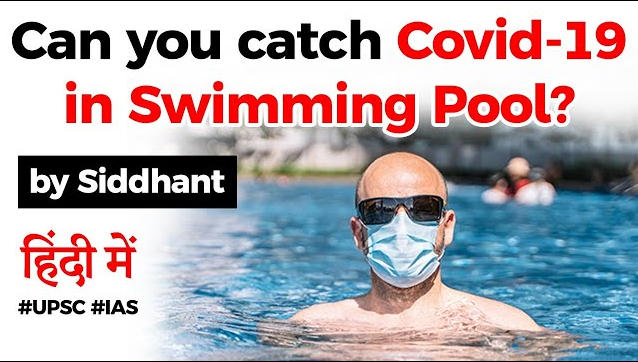Table of Contents
CORONA
- While swimming in itself is seen as the safest sport with its virus-killing chlorine cover, getting into the pool and back is fraught with risks.
- Given the inability to enforce strict social distancing on land, authorities in India have been reluctant to open pools for amateur swimmers, whose numbers will need to be severely restricted.
Is it safe to swim in the pool?
- “The virus doesn’t respect borders,” said Dr Chandrakant Pandav, former head of community disease at AIIMS. “There is no evidence that the virus spreads in water, but given transmission happens through the nose and water, and enforcing 100% protocol can’t be guaranteed, we shouldn’t be taking a risk.”
Can chlorine secure the pool?
- The World Health Organization says, “swimming in a well-maintained, properly chlorinated pool is safe.” USA Swimming, the governing body in America, has mandated 2.0 ppm chlorine in pools. That level of chlorine will kill the virus, but hiking it even to the permissible 3 ppm can cause irritation on the skin and in the eyes, and harm the stomach lining if water is consumed.
- Dr Pandav said chlorine isn’t a one-stop solution. “You have to ask: how well is the chlorination done? Well-chlorinated means ensuring the powder/gaseous chlorine is working efficiently in the water and the concentration percentage is maintained at all times, because it deteriorates. The disinfecting effect wears off, and can you guarantee 2% is maintained at all times?”
What other measures are recommended?
- US guidelines limit the capacity to 27 in a short-distance (25-yard) pool and 60 in an Olympic-sized 50 m pool for recreational swimmers. Each lane — usually 6 in the shorter and 10 in the longer pools — need to be 8 feet wide.
- When the UK opens its pools, it is looking at restricting swimming to the clockwise direction and merging two lanes into one. It has advised constant supervision to exclude those feeling ill, handwashing, and avoiding change rooms. Australian guidelines specify only one swimmer per lane; the Indian recommendations include temperature checks.
What are the problems in resuming swimming in India
- Although the Sports Authority of India (SAI) has asked for recommendations to prepare SOPs, state government authorities have the final word on pools in their jurisdiction.
- Elite swimmers expect pools to open no sooner than the fourth Unlock phase (Unlock 2.0 that extends until July 31 mandates that pools stay closed).
- As uncertainty persists, coaches, cleaners and lifeguards are struggling with salaries and leases on the line.
What is the situation elsewhere?
- Before cases started climbing again last week, Australia and Singapore had looked on track to reopen their pools and increase the numbers gradually. However, Australia waited until there were zero new cases.
- Sri Lanka, Thailand and Vietnam, popular training bases in Asia, have taken tentative steps. “While recreational swimming looks highly unlikely, we need elite swimmers to start training,” said Bengaluru-based coach Nihar Amin. “We’ve spent our entire lives protecting swimmers’
What are the risk areas?
- Even 10-15 at a time in different lanes are seen as a risk, as are taking a break along the walls, and using the blocks and change rooms. “We don’t just swim and go home. We’ll drink water, there’ll be some place where we keep our bags, and it’s tough to maintain 10 ft distance that I personally think might be safe at all times,” said international swimmer Srihari Nataraj.
Why is India reluctant to resume?
- Neither SAI nor the Sports Ministry has offered clarity. SAI has an agreement with Australian Institute of Sport in Canberra and could explore that option for elite swimmers. However, no one is willing to risk reopening for recreational swimmers who might throng public pools.
- Dr Ashok Ahuja, former department head (Sports Medicine) at SAI, said reopening is a bad idea. “I don’t think pools are safe. It’s a new virus and the entire nature of its spread through water with body secretions like saliva and sweat despite chlorine disinfection is not proven. From sports medicine point of view, we should not let pools open… Let’s wait till December for recreational swimmers.”
- For the competitive lot, Dr Ahuja recommends only one swimmer at a time, at staggered times.
Latest Burning Issues | Free PDF






















 WhatsApp
WhatsApp